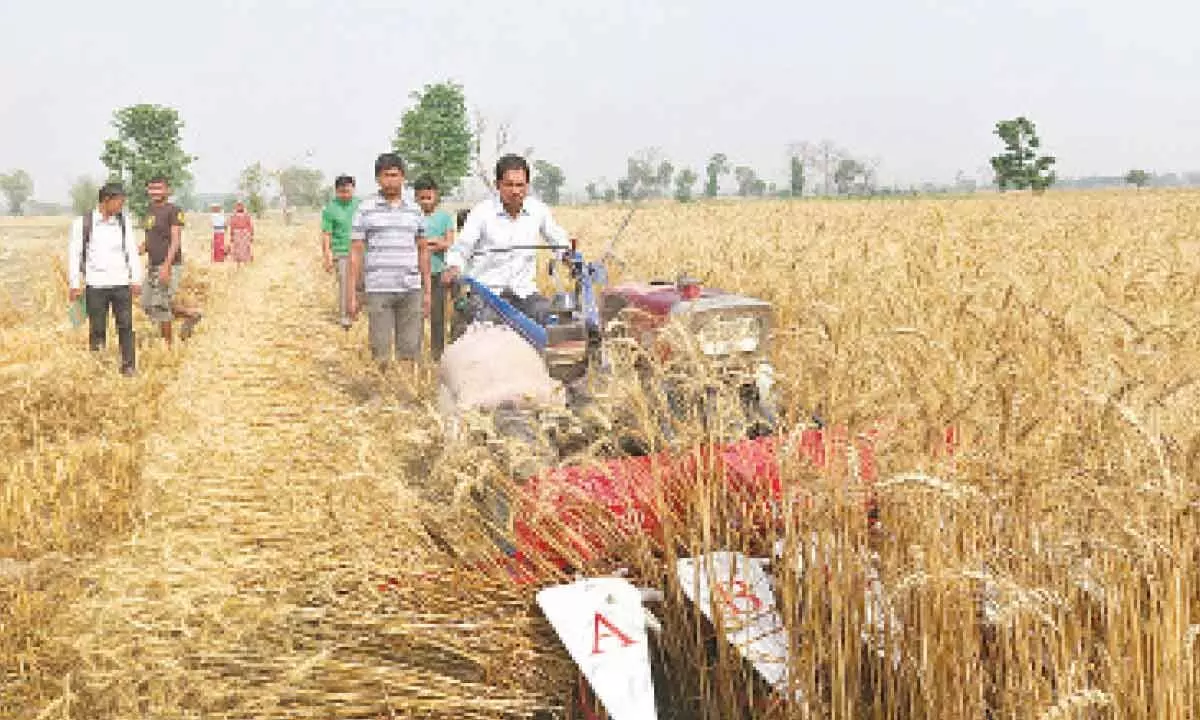Live
- Govt open to discuss all issues, says Kiren Rijiju on eve of Winter Session of Parliament
- Pakistan reports three new polio cases, 2024 tally reaches 55
- Multifold Increase in migratory bird population at TN bird sanctuary
- Archaka Maha Sabha in Jogulamba Gadwal District Highlights Key Demands for Priests' Welfare
- IPL 2025 Auction: Both Rahul and Starc are world-class players, says Delhi Capitals head coach Badani
- Committed to the Welfare of Brahmins - MLA Kuchukulla Rajesh Reddy
- MLA Shri Ganesh Participates in Maha Sudarshana Homam and Srinivasa Kalyanam in Secunderabad
- Terror hideout busted in J&K's Kupwara district
- PM Modi to throw open global cooperative conference on Monday
- Toyota Kirloskar Motor Celebrates “Namma Kannada Habba 2024” Japanese CEO Wins Hearts with Fluent Kannada
Just In
Should India export wheat to Nepal?


Nepal’s domestic production is enough for consumption of wheat in its natural form in the households. But there is not enough production of glutinous durum wheat which are used in certain industries to produce noodles, pasta, breads, biscuits among others. Whether having enough wheat for the processed wheat products should also be a part of food security is to be decided upon by India in respect of Nepal. India imposed a ban on wheat exports in May last year
Kathmandu: Nepal has formally requested India to supply 3,00,000 tonnes of the wheat to meet the demand of the flour mills amid India's ban on wheat exports since May last year. Even though India in December last year fixed a quota of 50,000 tonnes for supplying wheat to Nepal, Nepal-based flour mills have been seeking supply of more wheat from the southern neighbour.
Flour prices have skyrocketed in the Nepal market and subsequently, the price of biscuits, noodles and breads have also surged in recent months. "It has been 14-15 days since we sent a request to India for the supply of 300,000 tonnes of wheat meant for Nepal's flour mills," Narayan Prasad Regmi, spokesperson at the Ministry of Industry, Commerce and Supplies told India Narrative.com. "The request was sent through the diplomatic channel." He said that additional demand for wheat was sought after supply of 50,000 tonnes in the past was not adequate for Nepal's industrial consumption.
"As per our demands, the government sent the request to India for supply of additional wheat," Dinesh Kumar Agrawal, senior vice-president of Nepal Flour Mills Association told the India Narrative. He said that his association has called the Nepal's government to make a request for the supply of 700,000 tonnes of wheat required for the country within a year.
India imposed a ban on wheat exports in May last year after a freak rise in temperatures impacted the harvest there. In March 2022, a heatwave curtailed India's wheat production to 100 million tonnes against local consumption of 103.6 million tonnes, according to the reports. India faced another heatwave in northern and central India earlier this year. The heatwave appearing at a time the crop is ripening is threatening to damage grains and dent the country's wheat production for the second straight year, the reports said.
As per the protocol to trade between Nepal and India which was last renewed in 2016, where needed by one contracting party, the other shall authorise exports of goods which are in export ban category, subject to specific annual quota allocations. The quota list may be jointly reviewed as and when necessary, the protocol to the treaty states. "In line with the provision of treaty, India had exported rice to Nepal in 2007-08 within a month after India imposed global export ban on rice," Posh Raj Pandey, executive chairperson of the South Asia Watch on Trade, Economics and Environment (SAWTEE), a Kathmandu-based think tank focussed on international trade, told the Indianarrative.
Nepal also produces wheat. According to Nepal's Ministry of Agriculture and Livestock Development, annual production of wheat in Nepal has been over two million tonnes in recent years. "Nepal's domestic production is enough for consumption of wheat in its natural form in the households," said Regmi. "But there is not enough production of durum wheat which are used in certain industries to produce noodles, pasta, breads, biscuits among others." Durum wheat yields a glutinous flour.
Sunil Kumar Singh, senior agricultural economist at the Department of Agriculture under the Agriculture Ministry said that there have been a few efforts to grow the durum wheat in the country but it has been difficult to convince the farmers. "The farmers are concerned whether such wheat could be sold in the market provided the flour mills refuse to buy domestic wheat because of cheaper Indian wheat," he said. But reduced availability of glutinous flour has resulted in price rise of everything that is produced with durum wheat. Industries have either increased the prices of the wheat flour-based products or reduced the quantity to adjust the cost of production. "The price of per kg wheat increased to NPR 40 now from NPR 32 at the same time last year," said Agrawal. "That's why, it has been difficult for us to keep the price of wheat flour down."
SAWTEE Chairperson Pandey said that the food security situation of the country should not just be judged based just on household consumption of wheat in its natural form. "Consumption of processed wheat products has also been a rising trend in Nepal's culinary culture. So, whether the country has enough wheat for the processed wheat products should also be a part of ensuring food security of the country," he said.
(Prithvi Shrestha writes for India Narrative from his perch in Kathmandu)

© 2024 Hyderabad Media House Limited/The Hans India. All rights reserved. Powered by hocalwire.com






